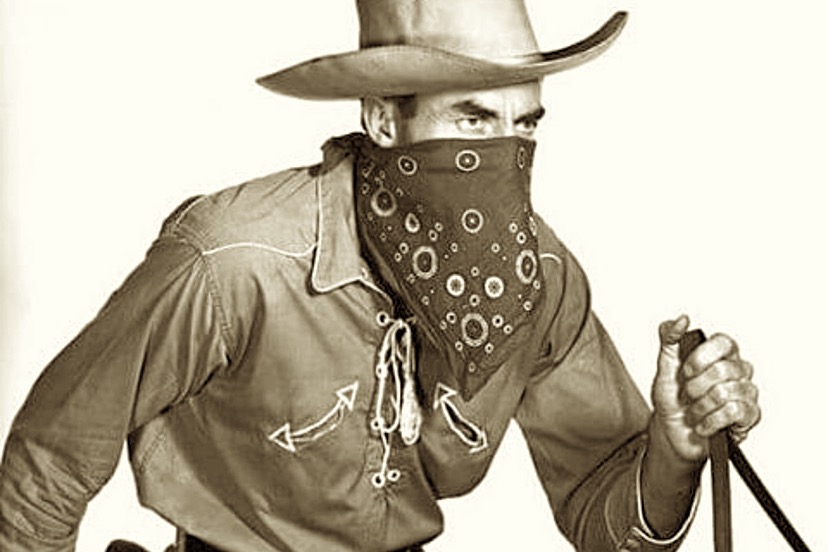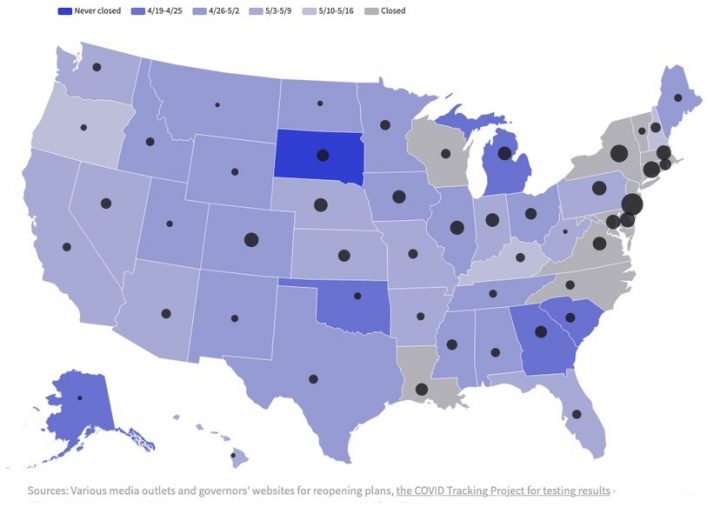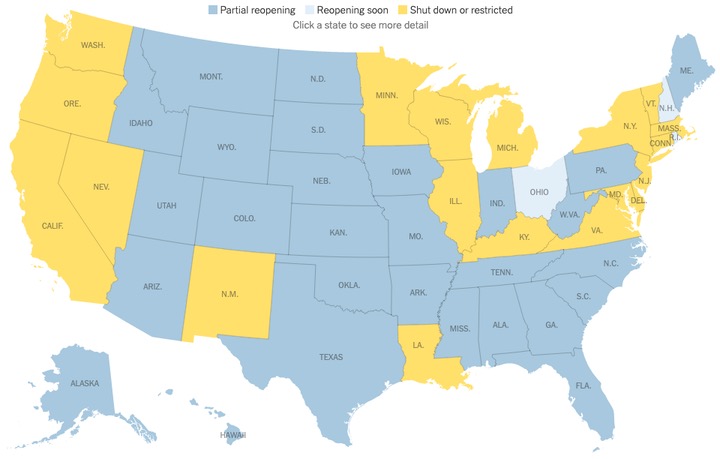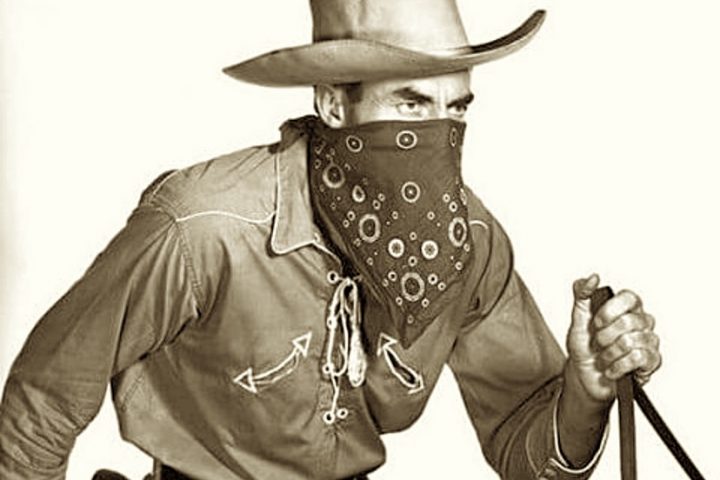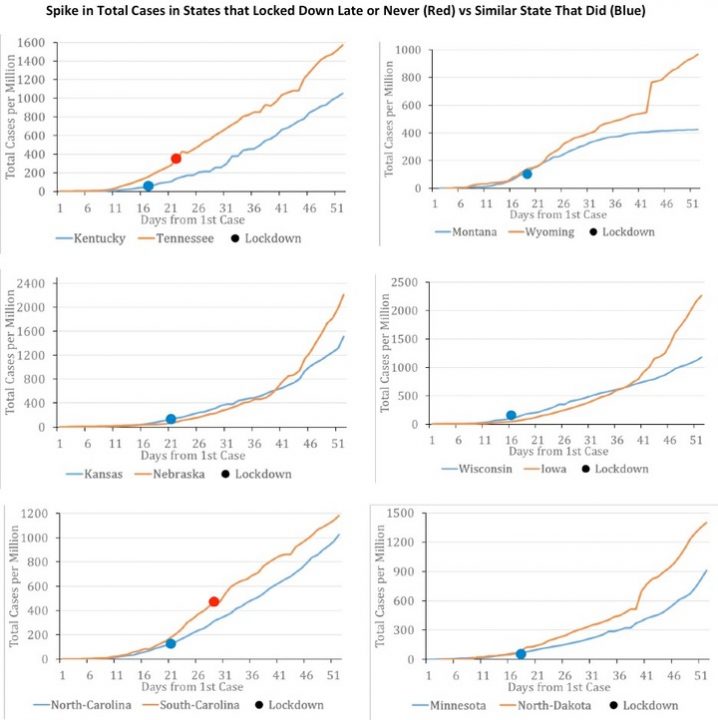Last week, Governing Magazine, at governing.com, posted a summary of ‘reopening’ schedules for all 50 US states, along with an interactive map created by reporters Carl Smith, Ben Miller and Paul W. Taylor.
The map looks like this, in its ‘non-interactive’ state:
The black dots show the relative percentages of ‘tests’ that have come back ‘positive for coronavirus’. We know that some states are testing only people showing symptoms while other states have different criteria. Additionally, it’s not clear whether all US states are using the same tests, or which tests are accurate and which are not.
So the ‘relative percentages’ might mean little to nothing.
The ‘re-opening dates’ are a bit more definite, but ‘reopening’ in Georgia doesn’t necessarily mean the same thing as ‘reopening’ in Colorado. Nor do journalists always interpret the term ‘reopening’ in the same way.
Here’s a May 8 map published by The New York Times, based on the reporting of Sarah Mervosh, Jasmine C. Lee, Lazaro Gamio and Nadja Popovich, which displays the ‘reopening’ data in a slightly different fashion:
Obviously, the definition of ‘locked-down’ depends on your definitions, and your journalistic perspective.
Here’s a summary of some western states, based on the Governing summary. You can read the full summary and view the interactive map on their website.
Alaska Gov. Mike Dunleavy of Alaska announced Phase I of the Reopen Alaska Responsibly plan. Individuals are no longer required to stay at home. They are asked to maintain social distancing and to wear cloth face coverings at gatherings that involve multiple households. As of April 24, restaurants and retails businesses were allowed to open at 25 percent capacity. Indoor and outdoor religious, social or other gatherings are limited to 20 people, with face covering suggested.
New cases are trending stable.
Arizona Gov. Doug Ducey announced changes beginning on May 4 and continuing on May 8. Customers are advised to cover their nose and mouth with a face covering and to practice social distancing. As of May 4, retail businesses not classified as “essential” are allowed to offer goods through means such as delivery, curbside service, window service, etc. As of May 8, they will be allowed to open their stores if they maintain social distancing and sanitation standards.
New cases in Arizona had been trending upward for several weeks.
California Gov. Gavin Newsom allowed the state to begin reopening on May 8. Some retail stores can begin curbside sales, as can restaurants. Manufacturing is allowed to commence. Some trails and beaches are open for ‘active’ recreation such as jogging. Officials have laid out criteria for counties to open sooner than the state more broadly, including opening restaurants for dine-in service.
New cases are trending higher.
Colorado Governor Jared Polis announced an Executive Order modifying the state’s Safer at Home guidelines and providing series of phases for reopening his state. Beginning Monday, April 27, non-critical businesses were allowed to provide delivery service, window service, curbside service. On May 1, retail and personal service businesses could open if they follow social distancing requirements and cleaning protocols. On May 4, offices were allowed to open with a 50 percent reduction in staffing. To support this, childcare facilities will be allowed to reopen or expand. Local governments are allowed to implement or guidelines that are less restrictive, provided they provide proof that infection has declined for 14 consecutive days in their county and submit a written COVID-19 suppression plan “approved by the appropriate local public health authority, all hospitals within the jurisdiction, and elected leadership.”
New cases are trending slightly higher.
Hawaii Gov. David Ige signed a Supplementary Emergency Proclamation that would allow some businesses in the state to reopen at 12:01 am on May 7. Businesses allowed to reopen include car dealerships, car washes, licensed child-care facilities, pet grooming services, retail and repair services and non-food agriculture. Occupancy is to be limited to a number that will allow social distancing. Beaches remain closed.
New cases in the state have been trending significantly downward for several weeks.
Idaho Gov. Brad Little issued a Stay Healthy Order on April 30 that became effective May 1. Businesses in the state are allowed to open if they follow social distancing and sanitation guidelines outlined in the order. Restaurants are allowed to serve take-out orders. Bars, Nighclubs, theaters, sporting venues remain closed. Citizens are “strongly encouraged” to use face coverings.
Cases in the state are on a long-term downtrend.
Kansas Gov. Lisa Kelly presented A Plan to Reopen Kansas, a detailed framework for reopening the Kansas economy. Phase One began on May 4, the day on which the state’s current stay-home order was lifted. Citizens are encouraged to wear a cloth face mask when in public and gatherings are limited to 10 persons. During Phase One, certain businesses will not be allowed to reopen. These include bars and nightclubs (except those already providing curbside and carryout food service), theaters and museums, casinos, fitness center and gyms, and personal service businesses. All other businesses are allowed to open, provided they maintain social distancing.
New cases in Kansas continue to trend upward.
Montana began a phased reopening of businesses on Monday, April 27. Stay-at-home orders for individuals expired on April 26. They are advised to ‘strongly consider’ using non-medical face coverings, practice social distancing and avoid gatherings of more than 10 people. Vulnerable populations, including those with underlying medical conditions, are encouraged to continue to stay at home. On April 27, main street and retail businesses were allowed to open ‘if they can adhere to requirements to limit capacity and maintain strict physical distancing.’ Employers are directed to develop to screen and protect workers and to safeguard customers. Restaurants and bars were allowed to resume in-establishment services under reduced capacity and social distancing guidelines beginning May 4.
New cases in Montana have been trending downward for several weeks.
Nebraska Gov. Pete Ricketts announced on May 24 changes to restrictions on business operations and social gatherings, to go into effect on May 4. Each county in the state has its own health department, and each will issue its own Directed Health Measures (DHMs). The CEO of the Nebraska Department of Health and Human Services outlined plans to mobilize 1,000 people to assist with contact tracing.
New cases in Nebraska continue on an upward trend.
New Mexico Gov. Michelle Lujan Grisham announced an April 30 extension of an emergency public health order that would ease some restrictions on businesses. As of May 1, non-essential retailers were allowed to provide curbside pickup and delivery services, and child care is extended to the owners of such businesses.
New cases in the state have been trending upward.
Utah Gov. Gary Herbert of Utah issued an Executive Order on April 29 that placed the state under “moderate risk” protocols as of May 1. Employers and the public are both encouraged to take ‘extreme precautions’ such as wearing masks in places where social distancing is difficult to maintain, limiting social activities to groups of 20 or fewer and to follow standards provided by the CDC. Both customers and employees are to wear face masks in retail businesses, and occupancy is limited to one person per 10 square feet. Gyms and fitness centers are allowed to open if they follow guidelines in the plan.
New cases in Utah are trending upward.
Washington Gov. Jay Inslee released his phased plan for reopening his state, Safe Start Washington, on May 4. On the same day, he issued a proclamation that would allow limited business operations to resume on May 5 under Phase 1 of the plan. Retail can operate on a curbside pick-up basis. Social gatherings of any size remain prohibited. As of May 5, a number of outdoor activities are allowed, including golfing, hiking, biking, hunting and fishing, boating and day use of parks and public lands. Drive-in religious services are permitted.
New cases in Washington show a slight upward trend.
Wyoming Gov. Mark Gordon announced new public health orders that allowed certain businesses in his state to reopen on May 1. Restaurants are not yet allowed to provide in-house dining. Gyms will be permitted to open if they abide by guidelines including face coverings for staff, limiting patrons and closing locker rooms. Gyms are also prohibited from offering one-on-one personal training and group classes. Personal care businesses, including hair salons, barber shops and tattoo and massage parlors can reopen. Guidelines for these facilities include a requirement for staff and patrons to wear face masks, limiting the number of people in a confined space to less than 10, and providing service only on the basis of appointments.
New cases in Wyoming are trending slightly higher.
A newly release study compared the decisions in neighboring US states whether, and when, to ‘lock down’ their economies. The study, titled “Price of Delay”, was posted on the open-source, early stage research platform Social Science Research Network (SSRN) by Gerard Tellis, Neely Professor at the USC Marshall School of Business; Ashish Sood, Associate Professor at University of California, Riverside; and Nitish Sood, from Medical College of Georgia at Augusta University.
The authors chose to research the question: ‘Are lockdowns really effective?’ They found that the growth rate of the disease is declining in all states — but as Professor Tellis explained, “Decline by itself could be due to better hygiene, social distancing, or lockdowns. To capture the sole effect of lockdowns, one has to identify two neighboring states that are similar in every respect, except the date of lockdowns. We identified seven such pairs.”
The state that locked down later, or not at all, showed an increase in per capita cases in this comparison study.

